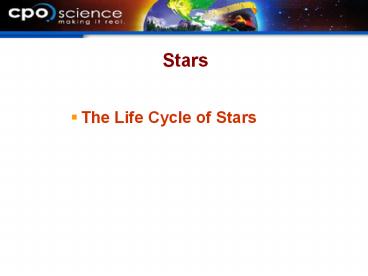Stars - PowerPoint PPT Presentation
1 / 20
Title:
Stars
Description:
The life cycle of stars A star, regardless of its ... Examining light from stars Spectroscopy is a tool of astronomy in which the light produced by a star or ... – PowerPoint PPT presentation
Number of Views:231
Avg rating:3.0/5.0
Title: Stars
1
Stars
- The Life Cycle of Stars
2
Learning Goals
- Describe the events that occur at different
stages in the life cycle of stars. - Apply knowledge of nuclear fusion to explain how
elements are created in stars. - Discuss the significance of spectroscopy in
classifying stars.
3
The life cycle of stars
- A star, regardless of its size, begins its life
inside a huge cloud of gas (mostly hydrogen) and
dust called a nebula. - The Eagle Nebula is the birthplace of many stars.
4
The life cycle of stars
- A protostar is the earliest stage in the life
cycle of a star. - The Orion Nebula was the birthplace of these
protostars.
5
The life cycle of stars
- A star is born when temperature and pressure at
its center become great enough to start nuclear
fusion. - Once nuclear fusion begins, a star is in the main
sequence stage of its life cycle.
6
The life cycle of stars
- The time a star stays on the main sequence
depends on the stars mass. - High-mass stars burn brighter, and hotter, using
up their hydrogen faster than low-mass stars.
7
The old age of Sun-like stars
- As our sun grows old, its core begins to run out
of hydrogen fuel. - Gravity then causes the core to contract, raising
the temperature. - The hotter core pushes the outer layers of the
star away, then star expands into a red giant.
8
The old age of Sun-like stars
- With no more energy flowing outward, nothing
prevents gravity from crushing the matter in the
core together. - When hydrogen fusion stops, the core glows
brightly and is called a white dwarf.
9
The old age of Sun-like stars
- A planetary nebula forms when a star blows off
its outer layers leaving its bare core exposed as
a white dwarf. - Planetary nebulae are one of natures ways of
recycling the matter in old stars and
distributing new elements.
10
Supernovae and synthesis of the elements
- Scientists believe the early universe was mostly
hydrogen, helium and a trace of lithium. - Heavier elements are created by nuclear fusion
inside the cores of stars. - Nuclear fusion reactions are exothermic,
releasing energy only up to iron. - When the core of the star contains mostly iron,
nuclear fusion stops.
11
Supernovae and synthesis of the elements
- If a stars iron core reaches 1.4 times the mass
of the Sun, gravity becomes strong enough to
combine electrons and protons into neutrons. - During this brief period, heavier elements such
as gold and uranium are created, as atomic nuclei
are smashed together. - The core of the star collapses and the result is
a spectacular explosion called a supernova.
12
Supernovae and synthesis of the elements
- The Crab nebula is the remains of a supernova.
- Chinese astronomers recorded its demise 1054 AD.
13
(No Transcript)
14
Examining light from stars
- Spectroscopy is a tool of astronomy in which the
light produced by a star or other object (called
its spectrum) is analyzed.
15
Analyzing light from stars
- A spectrometer splits light into a spectrum of
colors and displays lines of different colors
along a scale. - Each element has its own unique pattern of
spectral lines.
16
Analyzing light from stars
- In 1861, Sir William Huggins used spectroscopy to
determine that the Sun and the stars are made
mostly of hydrogen.
17
Analyzing light from stars
- A few years later, Sir Joseph Norman Lockyer
observed a line at the exact wavelength of 587.6
nm. - He concluded that this must be an undiscovered
element and named it helium, after the Greek name
for the Sun, Helios.
18
(No Transcript)
19
Investigation
Star Life Cycles and the H-R Diagram
- Key Question
- How can we use an H-R diagram to know where a
star is in its life cycle?
20
New Pathways in Science
- Katherine Johnson began her career at the
National Advisory Committee on Aeronautics (which
later became NASA) in 1953. Johnson faced many
hurdles. At the time, women werent permitted to
attend briefings or put their names on reports.































